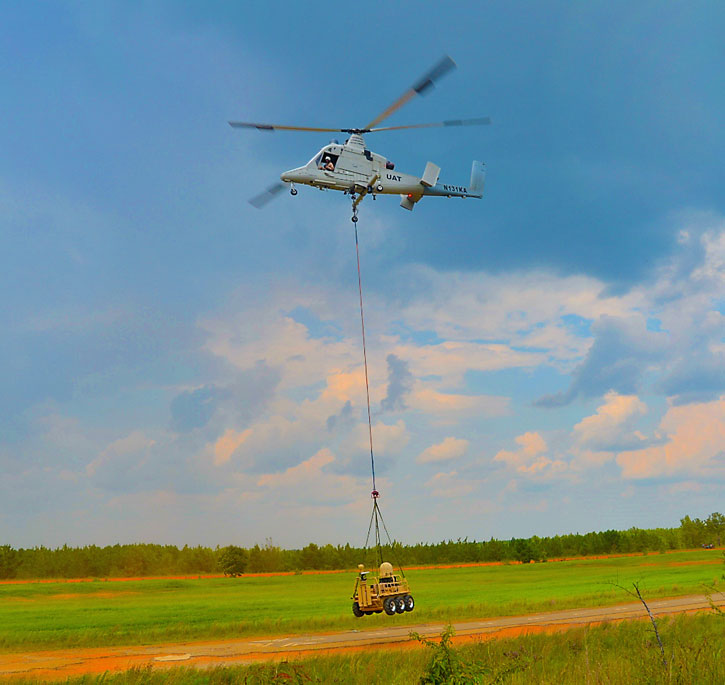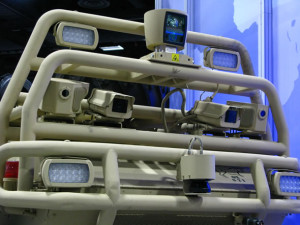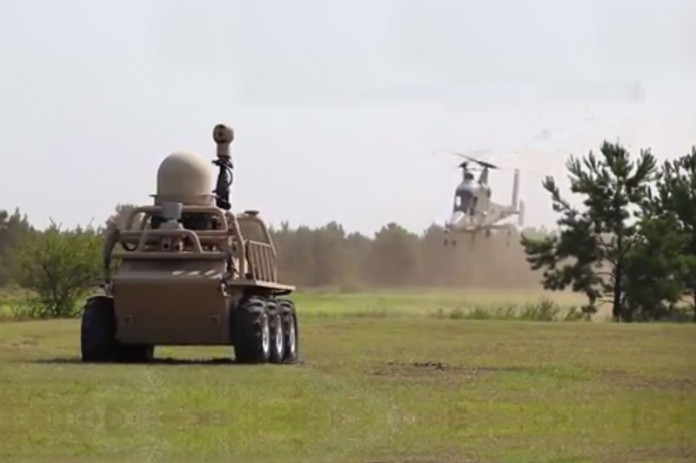

The U.S. Army Robotics Technology Consortium has funded a test employing an unmanned ground vehicle (UGV) and unmanned aerial system (UAS) tasked to perform a combined, autonomous reconnaissance, surveillance and target acquisition (RSTA) mission. The ‘Extend the Reach of the Warfighter through Robotics’ (ERWR) demonstration that took place at Ft Benning GA on August 7 joined two systems produced by Lockheed Martin – the Squad Mission Support System (SMSS) acting as the ground segment and the K-MAX unmanned air vehicle providing the aerial segment.
“Fully autonomous capabilities as we’ve just demonstrated will allow service members to focus on important missions and remain out of harm’s way,” said Scott Greene, vice president of Ground Vehicles for Lockheed Martin Missiles and Fire Control. “This successful demonstration with both unmanned air and ground vehicles shows us that these missions are not only possible, but can be available much sooner than you would expect.”
According to Joe Zinecker, director of combat maneuver systems at Lockheed Martin Missiles and Fire Control added that the technology demonstrated in the tests could lead to expanded missions, such as remote sensing and monitoring of suspected chemical, biological, radiological, nuclear and explosive threats or events. “This level of mission cooperation between unmanned air and ground vehicles of this size, controlled beyond line-of-sight, is an industry first” – Zinecker added.
During the test held at Ft Benning August 7, 2014 a K-MAX autonomous rotorcraft transported an SMSS via sling load into a simulated “area of interest” deemed too risky for human presence. The SMSS was equipped with a mast-mounted EO sensor (Gyrocam) and satellite communications (SATCOM) terminal providing the datalink. Its primary mission sensor was to deploy the mast-mounted Gyrocam EO payload for area surveillance. After deploying the UGV the The K-MAX monitored the area, positioning itself over the intended release point and autonomously set down, releasing the SMSS upon command from a remote operator.

Once delivered, the sensor-laden and satellite communications-equipped SMSS continued to assess the area using a combination of autonomous capabilities and tele-operation that was managed from a remote site, while the K-MAX returned to base.
The demonstration followed a 2012 exercise at Camp Grayling, Mich., in which a Gyrocam-equipped SMSS, operated via satellite from more than 200 miles away, successfully conducted a simulated reconnaissance mission. In this new scenario, the Gyrocam reconnaissance, surveillance and target acquisition sensor onboard the SMSS were used to locate, observe and obtain coordinates of targets and other objects of interest. The coordinates and sensor imagery were passed back through a satellite communications system to a remote operations center hundreds of miles away for analysis.
The current test was conducted in collaboration with the U.S. Army Tank Automotive Research, Development and Engineering Center (TRADEC).

















